September 13th, 2013 §
The angle of the sun has lowered in the last couple of weeks, and each sunset spills syrupy golden light across the farm. The garden that I could barely stand to look at a month ago has been reborn in this new light, and every cloudless evening it stuns me. That’s one of the lessons I’m learning as I work this garden—if I don’t like the view, wait a few weeks for some variables to shift and it will be different. I suppose that applies to life in general as well as gardening!

The Albelia ‘Rose Creek,’ above, in front, is covered in blooms. Each year I wonder why I keep these shrubs around, especially in winter when they’re lumps of leafless sticks. And then in early fall I remember how much I like them during this time of year.
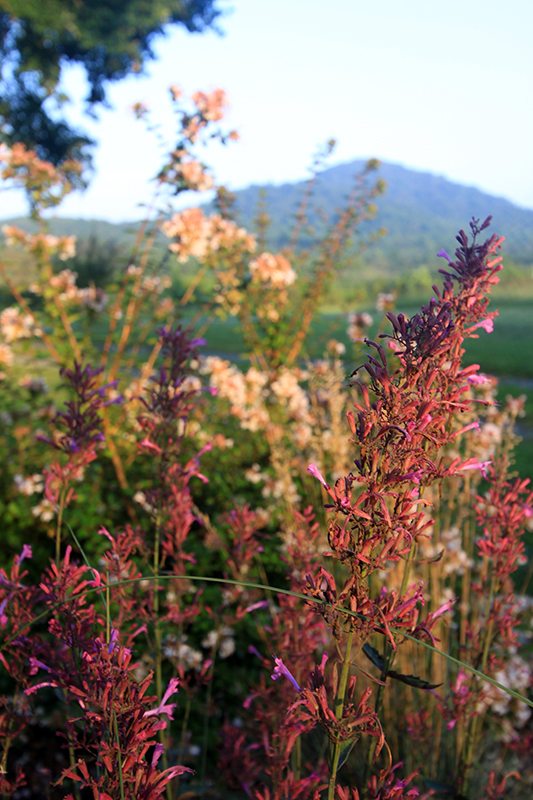
Here is is again, behind the Agastache ‘Bolero.’ The brown grass in between the two is blue fescue. I suspect that as the new perennials begin to fill in, this early fall picture will be even prettier.
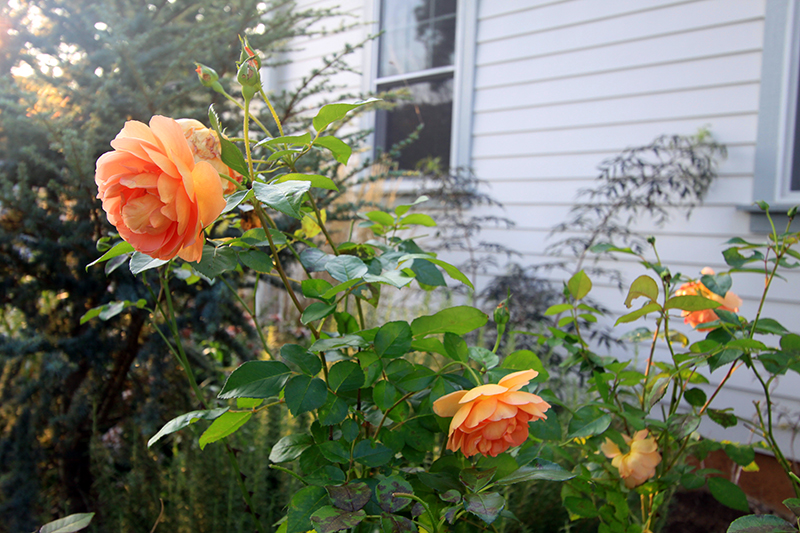
My David Austin rose, ‘Pat Austin,’ has recovered from her summer slump to proffer fresh foliage and fall blooms. I guess she liked that generous heap of homemade compost I piled around her ankles last month!
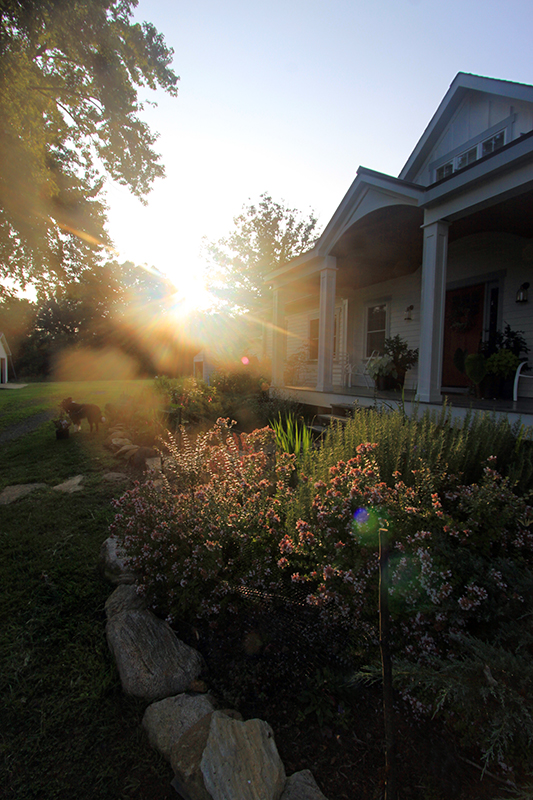
More backlit albelia
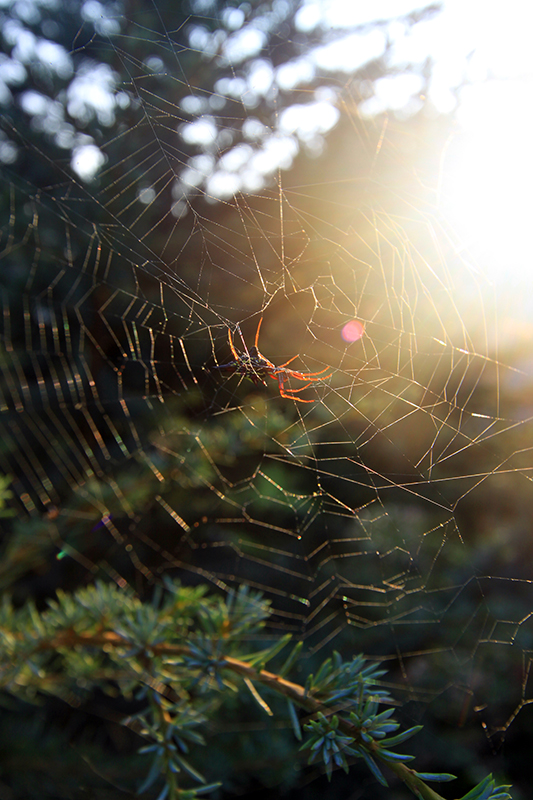
And finally, another one of the many spiders that are around this time of year. Here, one makes a home in the blue atlas cedar.
September 12th, 2013 §
In early August I was pretty sick of the house garden. Despite all the wonderful rain we’ve had this summer, which is unusual as we’re typically in a drought this time of year, the garden was looking tired. All I had going for me were some pretty garish purple phlox, which I appreciate as they bloomed for weeks and weeks.
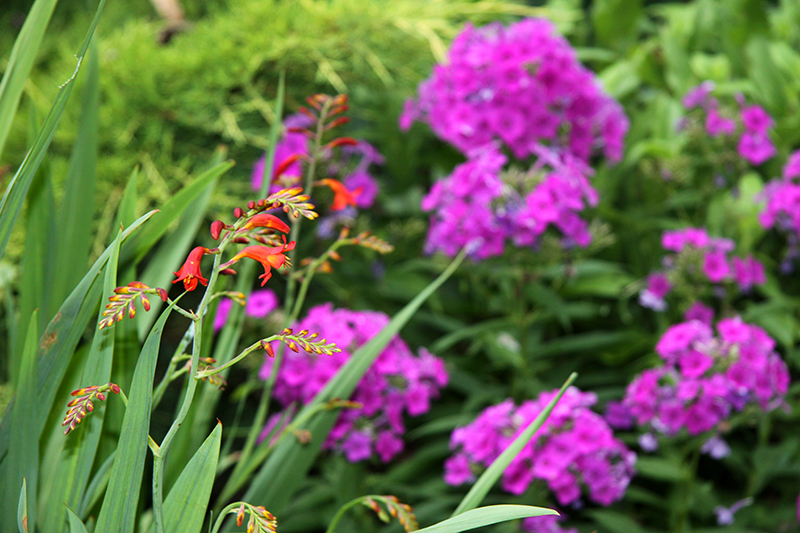
However, with no other purple plants in the garden to play off, they looked lonely and out of place. And they were clashing with some ill-placed Crocosmia ‘Lucifer,’ above. All around town I kept eying beautifully blooming gardens, and from studying them I realized I hadn’t planted any mid-to-late-summer flowering perennials.
So off I went on a search for some of the hardiest of these standbys, including echinachea, agastache, coreopsis, monarda, and salvia, among others. It was late enough in the season that I managed to score some of these for 50% off, filling my car with ratty-looking twigs on faith that they had enough life left in them to establish in my garden.
To gain space for this minimakeover, I did some pretty major surgery on some of the existing garden plants. I dug out an entire colony of purple German bearded irises that nestled beside my blue atlas cedar. I was torn about it, as I’d rescued these as just a couple of tubers tossed in my brother’s backyard, and for the past few years they’ve bloomed beautifully each spring and grown into a sizable feature in the spring garden, playing beautifully with the Deutzia ‘Chardonnay Pearls,’ which bloomed at the same time.
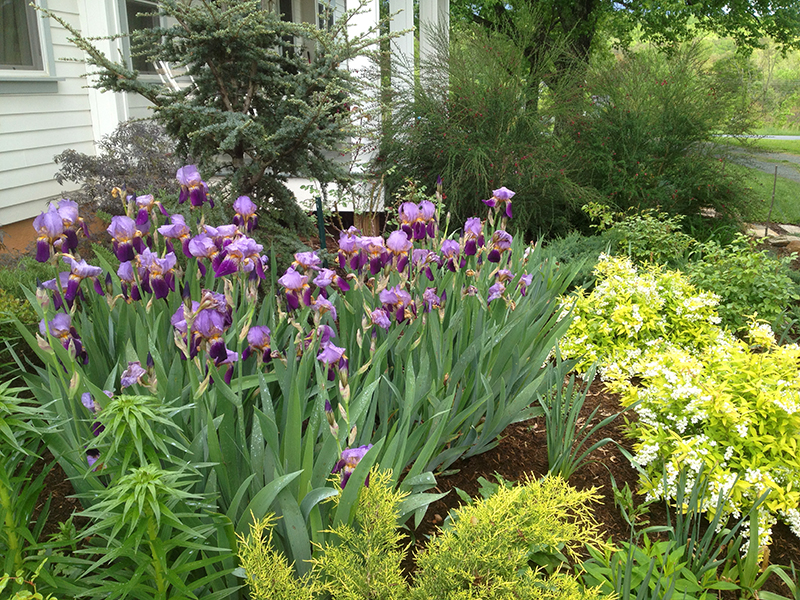 April 2013
April 2013
But this spring they were aflicted with iris leaf spot, and despite a couple of treatments, they weren’t able to shake it.
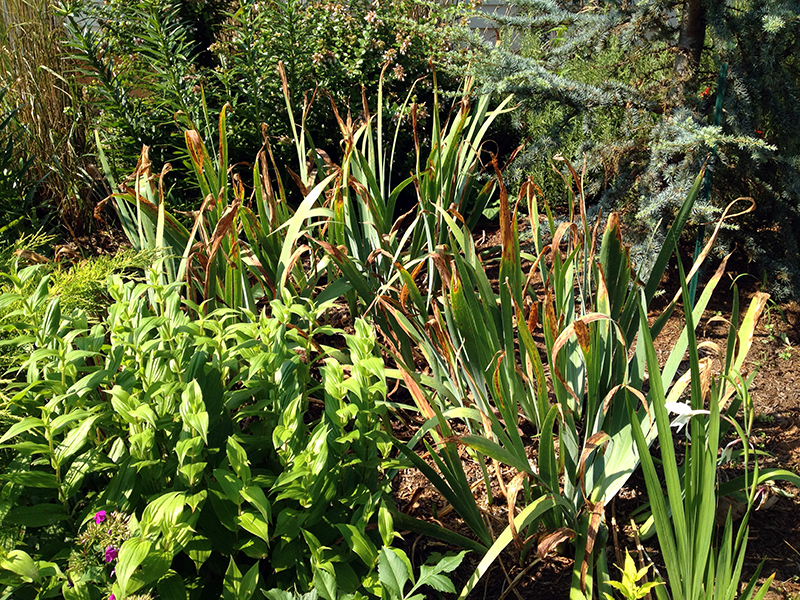 August 2013
August 2013
Iris leaf spot won’t affect blooming until late in the game, but it makes the foliage look so ratty that I couldn’t stand it, especially in such a promintent place in the garden. And I am not interested in spraying anything in my garden to keep it looking good. So out they came.
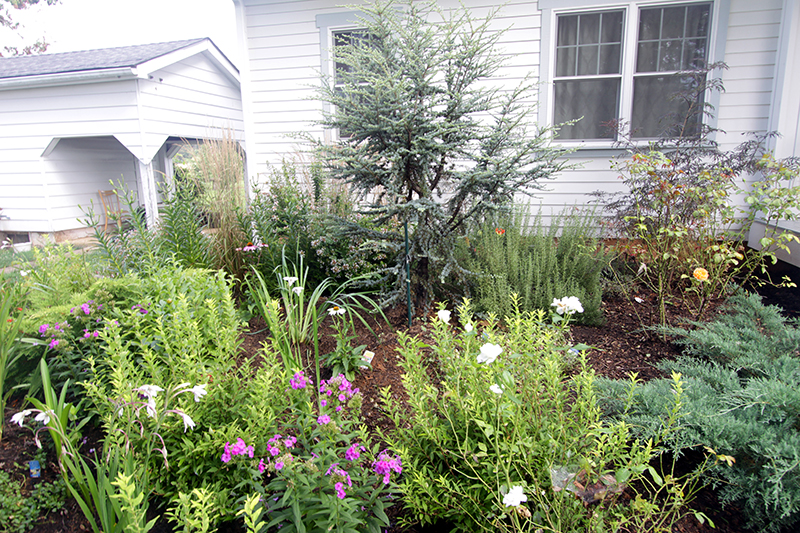
I replaced them with some echinacheas, which won’t give me the same spring bloom but should go crazy all summer. I chose Echinachea purpurea ‘Primadonna Deep Rose,’ for its relatively compact size and gorgeous flower color (not washed out and bland as I find some echinacheas to be) and ‘Primadonna White.’ I added a pot of Siberian iris (Iris sibirica ‘Ceasar’s Brother’). I know it’s a gamble to plant an iris back in the same soil afflicted with a soil-borne disease, but my trusted perennial guide Tracy DiSabato-Aust suggests that Siberian iris are less susceptible to iris leaf spot. I figured it was worth a gamble to return a purple-blue bloom to this place of honor. We’ll see. I also stuck another Siberian iris elsewhere, in unafflicted soil, and added a Japanese Iris (Iris ensata ‘Caprician Butterfly’) just for grins.
While I was on a tear, I also dug up another beloved bearded iris, ‘Precious Little Pink.’ This is a magical plant to me, and blooms in such a weird blue/purple/brown/pink color that’s just indescribable.
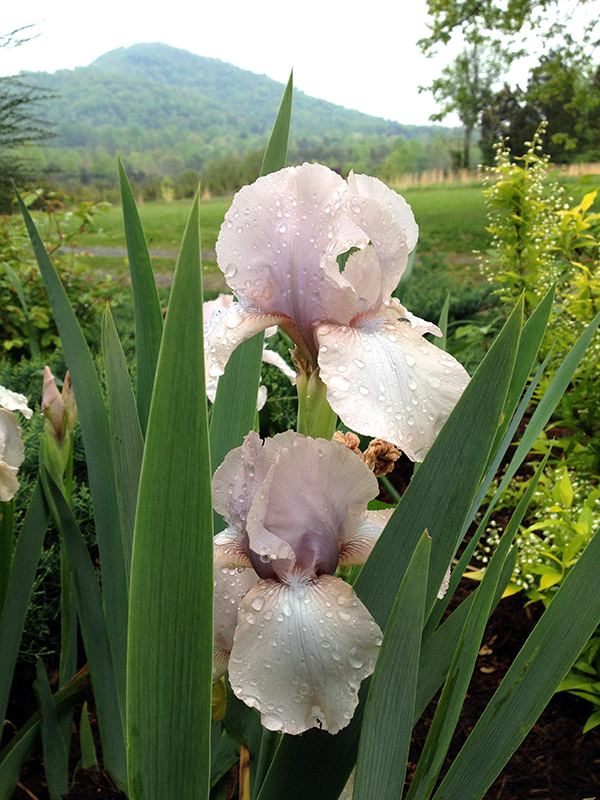 April 2013
April 2013
But it too was afflicted with iris leaf spot, so out it came. When it was out of the ground I discovered it also suffered from some rot and possible iris borer issues. And while I was in the mindset to dig irises, I rectified this unfortunate situation:
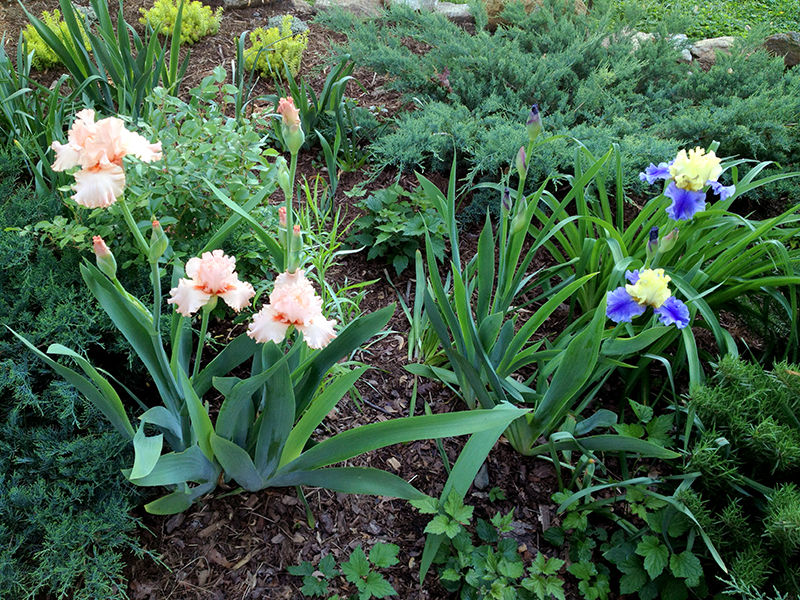
The horribly clashing blue and yellow iris (’Edith Wolford’) was relocated to the drainage ditch along the road, where I hope it will brighten the spring commutes of passers-by.
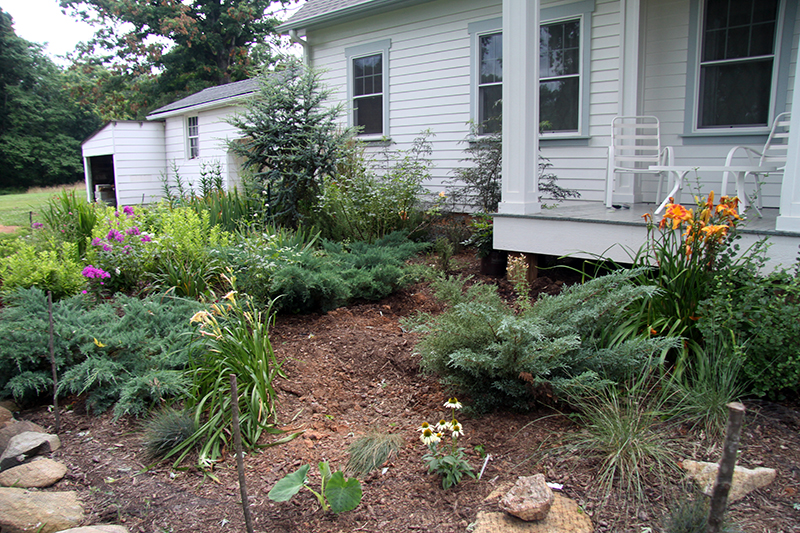
I also dug out all six of my daylilies, shown above along with the holes left from removing the Scotch broom. I had purchased the daylilies before the house was finished, again on deep clearance in the fall, and randomly plopped them in the ground to fill space. This year I finally realized that for the week or so that they bloomed, they took up too much space and looked boring. Plus, I am not a fan of bright orange and schoolbus-yellow blooms in this garden. So the daylilies had to go.
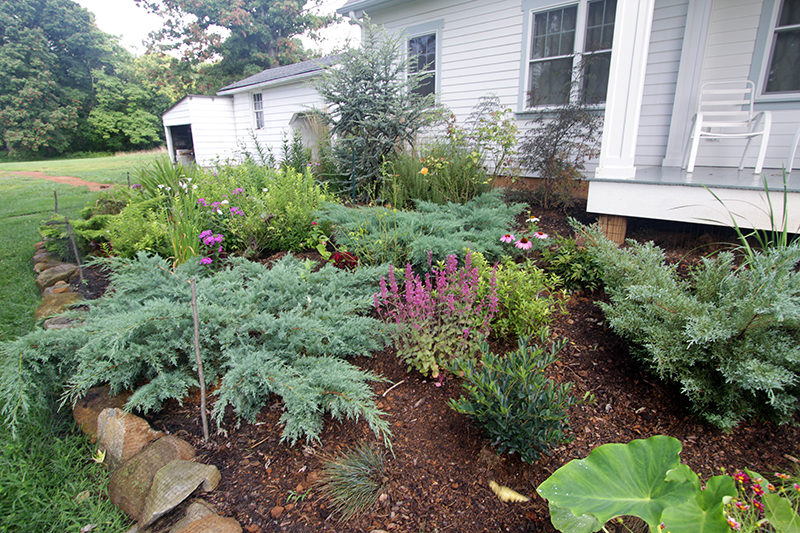
Looking better already! I added a few small evergreen shrubs to replace the Scotch broom. New additions are Nandina ‘Obsession,’ for red fall/winter color (near the porch corner) a relocated Deutzia ‘Chardonnay Pearls’, and a new plant to me, Distylium ‘Blue Cascade.’ (up front next to the elephant ears leaf). I’d been sold on the distylium’s virtues (uncommon deer, drought, clay and insect-resistant evergreen with small red winter flowers) while talking to a plantsman at our local fancy nursery, but he wanted $90 a bush. A few weeks later I found them at the local big-box hardware store for $25. Smaller plants, but that’s okay with me. I am curious to see how it does—it’s being marketed as a new foundation plant. Then I filled in around the new shrubs with a few perennials, including that purple spiky plant, Agastache ‘Bolero.’ It’s just gorgeous–with bronzy foliage and purple-blue blooms. The hummingbirds go nuts for it too. This an the new echinacheas help carry the purple phlox color across the garden.
I’ve still got all the removed iris and daylily tubers resting in the garage, and I plan to plant them back along the woodline. There they can bloom in the spring if they want and I won’t have to be worried about their disease-afflicted foliage later in the season.
It seems as though everything I planted got well-established. I realize things are planted pretty tight, but as you can see I am quite happy to thin and divide if the gardening gods bless me with successful growth. I can’t wait to see what the garden will look like as these flowering perennials begin to fill in and I find out if I was successful at addressing the issues I set out to fix.
September 9th, 2013 §
High summer’s butterflies, of which there appeared to be more than normal this year, have been superseded by spiders. Spiders, and spiderwebs, everywhere. Their aerial architecture has stopped me short several times this past week, shaking my head in disbelief. Just yesterday I looked out my second-floor window and saw, at eye-level, a strand of web that ran from the silver maple in the front yard to the red maple at the corner of the house—a distance of more than 50 feet. It looked like an electrical wire strung across my front yard, glinting as it twisted in the sunrise. Baffling and amazing.

There’s a giant Argiope aurantia that’s taken up residence in the front garden, and she is doing her part cleaning up the last of the dying butterflies. Common names for this common spider are “black and yellow garden spider,” “yellow garden orb weaver,” and most interestingly to me, the “writing spider.”
According to this page from the University of Michigan, the purpose of the thicker, white, zig-zag portion of the web, called stabilimenta, is controversial:
At least 78 species of spiders add these structures to their webs, originally named “stabilimenta” because they were thought to provide structural stability. One study of Argiope spiders supports the idea that these bright white structures attract flying insects (Tso 1998). Contrary to this “prey attraction hypothesis,” hungry spiders build fewer or smaller stabilimenta, and webs with stabilimenta capture fewer prey (Blackledge 1998, Blackledge and Wenzel 1999). A competing hypothesis is that the highly visible threads prevent birds from flying through and destroying the webs.
I like that last theory the best.
When I was a kid and we found these spiders around the house, my dad used to catch bugs and toss them into the webs to feed these wild and temporary pets. It was country entertainment to watch the the spider jolt as something hit her snare, and then quick as an arrow she flew to the bug and wrapped it end over end in silk. Sometimes the bugs were too large to catch in the web, and they’d tear big gashes in the delicate structures that were always, magically, repaired by morning. Some bugs would feed the spider for days, until we’d come outside and the desiccated carcass of the unfortunate grasshopper or whatever would have been cut out of the web and left to drop on the deck. And then it was time for us to go hunting again.
September 5th, 2013 §
Well the day I was anticipating arrived. Free ranging chickens in fox country means accepting, and living with, the risk that they’ll not come home one night. I’m surprised it took this long, actually. Just yesterday I was saying I hadn’t seen a fox in so long…
All the chickens were out all day today, roaming around. I left for only a short while this afternoon to go to the grocery. The dog was in the house while I was gone. I got back and saw some chickens in the yard, and all six babies were fine by the bushes. I didn’t count the chickens because they often break up into little groups that hang out in different places.
Tonight I put the babies to bed in the garage, and then noticed that only a few of the big chickens were hanging around the coop. I didn’t think much of it, as I figured the others were elsewhere. But at dusk I went to close the coop and there were only five chickens in there: Calabrese the rooster, Cora, Oregano, and the two Black Copper Marans hens, one of which is Dahlia. It’s never a good sign when the chickens don’t come home to roost.
So I got a flashlight and poked around all their favorite hidey holes before steeling myself for a trip into the woods. I knew what I would find, in some state or another. The chickens had taken to raiding the compost pile, which is set just into the woods, which is technically fox territory. I tried to keep it hidden from the birds, but once they discovered the delicious worms and solider fly larvae and food scraps, it became a place they visited several times a day.
Along the path into the woods, right where the snake appeared Monday, I found my first clump of black feathers. Then many, many more all the way to the compost pile. So that’s either Lilac or Iris, or both. The two Lavender Orpingtons are missing as well, but I didn’t find any of their feathers yet. I called for them, hoping they’d be hiding or injured and I could get them home and patch them up. It was getting dark and I didn’t really feel like hunting for more feather piles after finding the first. I just can’t understand that if it was a fox, how did it get four birds at once? I don’t know if foxes hunt in packs—I didn’t think so but I could be wrong. I would have expected them to grab one bird while the others ran for cover. And were was my rooster in the fray? I have seen him run across the entire pasture in response to a hen squawk. Maybe he was too far away?
Like I said, I knew this was coming. It’s one of the reasons why I wanted to raise up some babies this summer, as replacements for the inevitable casualties. And part of me is glad to be rid of the Lavender Orpingtons, mean as it sounds. One didn’t lay reliably, and the other always lay on the floor of the coop (which meant the dog got those eggs) and both of these hens always looked dirty and scraggly (despite baths, the last of which I just gave two nights ago). So no big loss there. But my egg production machine took a big hit with this loss of 2-4 eggs a day. Now I have only the Black Copper Marans as steady layers, as Cora never lays and Oregano does only when the mood strikes her. And it will be next spring until the new hens start laying, provided they don’t get eaten too.
I am a bit sad about Lilac and Iris. They were my first hens and really steady layers of distinctive eggs. They always looked clean and healthy. At their last molt their facial feathers had grown in white, which gave them a cute elderly look. They were in their second year of lay, which means they weren’t spring chickens but they were keeping up with the younger birds. Iris raised a flock of guineas as her own. Lilac’s chick is one of the six babies. And they had good personalities, steady and friendly, and were always the first to come running for treats. They ate copious numbers of bugs and fertilized the gardens, all while getting to live in the fresh air and sun and do whatever they wanted during the day while being protected at night. They had a rooster who loved them. I guess they had pretty wonderful lives.
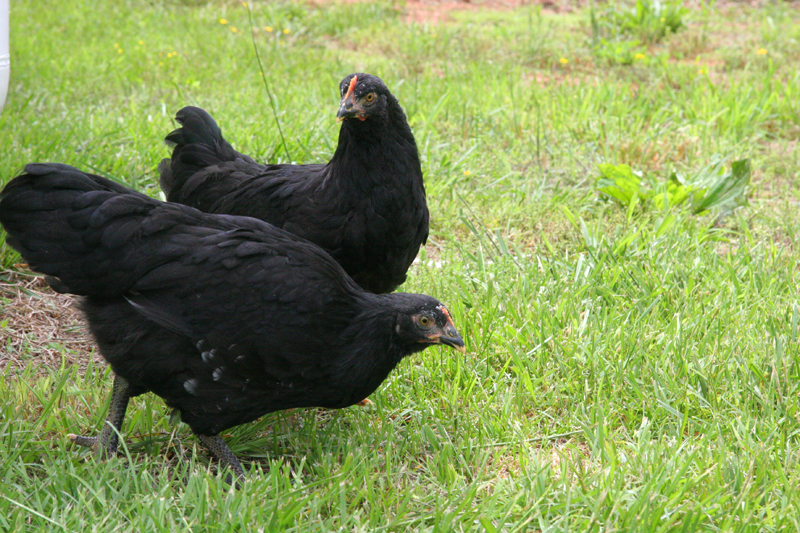
Here they are when I first got them. They were about the age of the baby chicks I have now. And here’s Lilac just two evenings ago, right up front, looking for handouts.
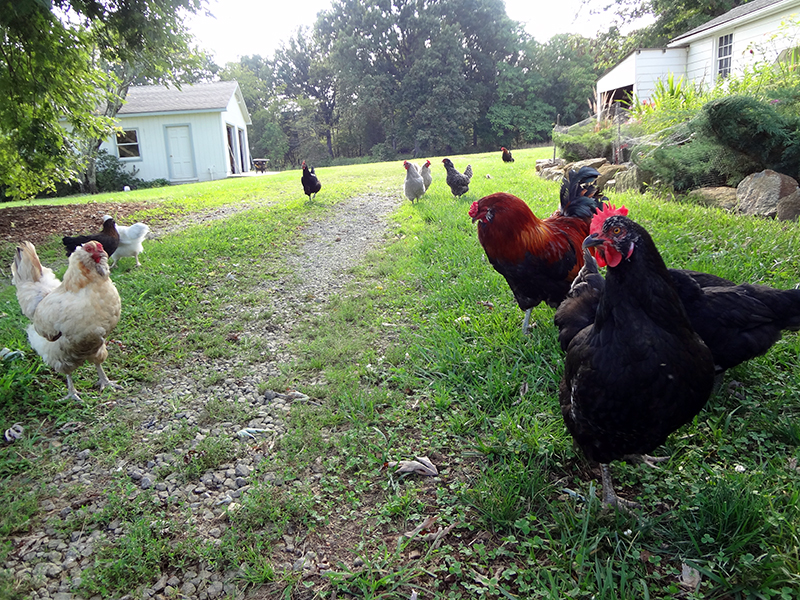
They were good chickens, but now they’re just stories and photos on the pages of this blog.
Goodbye, girls.
September 3rd, 2013 §
What happened to those damp little fuzzballs? Nothing remains of the chicks but their little peeping noises, which they still make when they aren’t busy practicing being grown-ups, crowing, and mating their siblings.
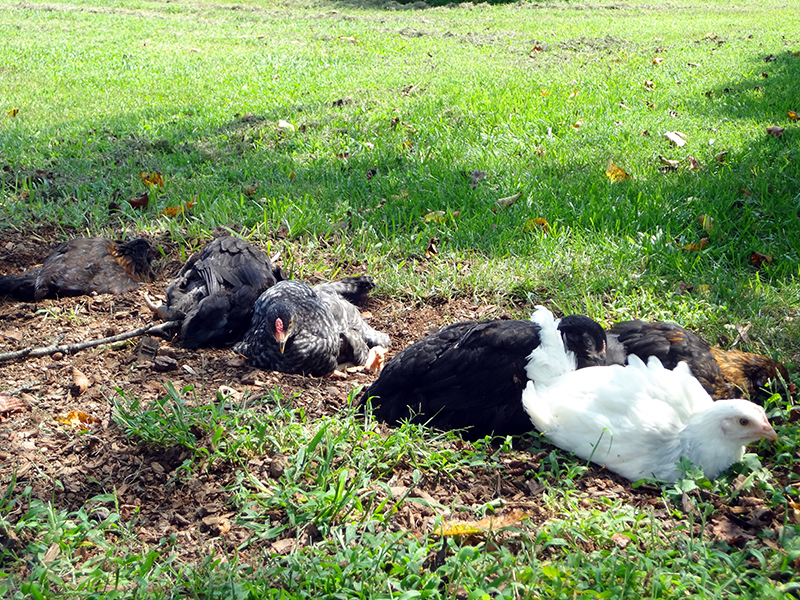
The chicks are now eight weeks old, and they are miniature chickens in most regards. This week I’ve let them find their own way out of their brooder coop and out of the garage into the wild world. They stick close to the bushes, dust bathing for hours in mulch, but each day they venture a bit further from their comfort zone. It’s wonderful to watch.
It looks like I have two cockerels: Griz, Oregano’s baby, and a Black Copper Marans/Wheaten Ameraucana mix. One thing I’ve really noticed is how much more flighty the chicks with the Black Copper Marans blood are. Makes sense, as their parent hens are the least docile of all my birds. Here’s the BCM/Wheaten Ameraucana cockerel, in front, with Griz behind, then the pretty black pullet hatched from Lilac’s egg, and finally a BCM/Wheaten Ameraucana pullet in back.
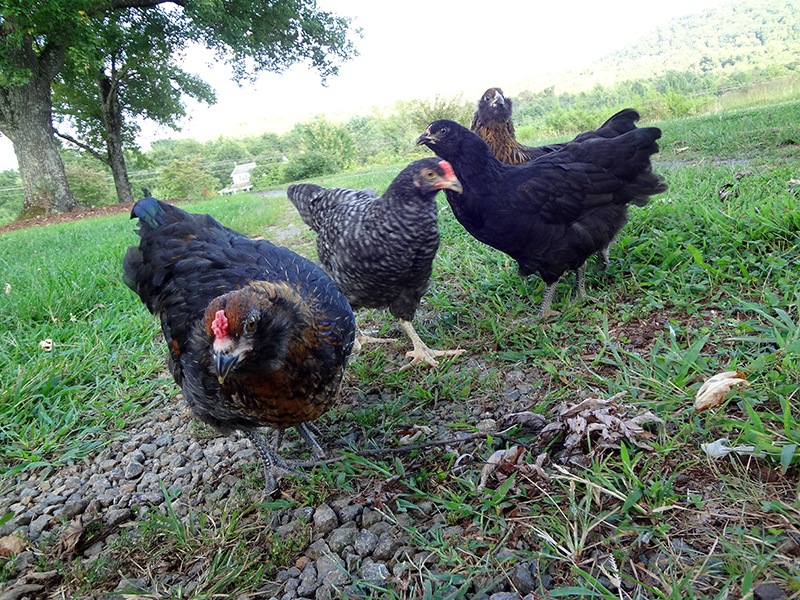
The homegrown birds all, except for Griz, have the cute facial feather tufting that comes along with their Wheaten Ameraucana blood. Interestingly, even though Griz’s father is a Wheaten Ameraucaua, he does not exhibit this feathering. Instead he looks like a straight-up Cuckoo Marans, which is blood that came from his mother’s line. So interesting to see genetics in action. Meanwhile, Griz learns just how palatable slippers are.
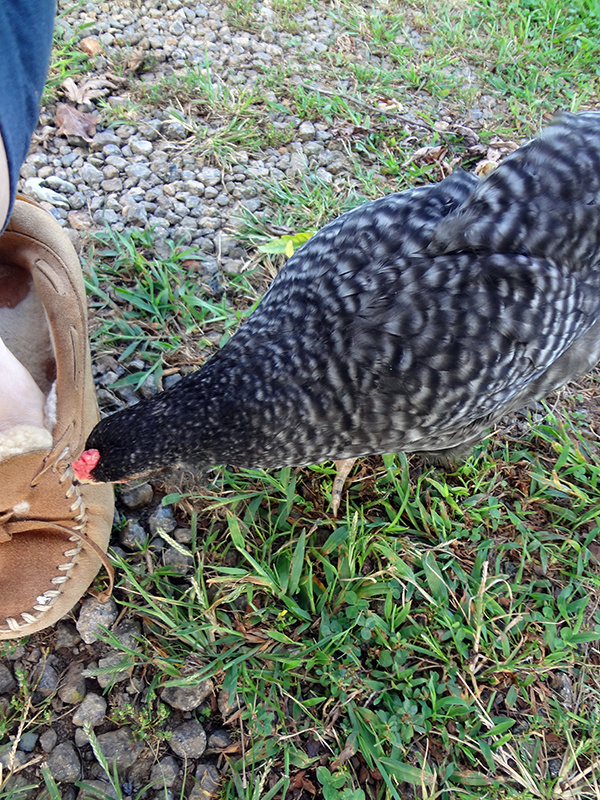
The white Coronation Sussex chick is, I believe, a pullet. Thank goodness. She is the sweetest of all six babies, always the first out of the coop and very amenable to being handled. Her lavender feathers are growing in around her head and tail, and I think she’s just so pretty. I have named her Calla.
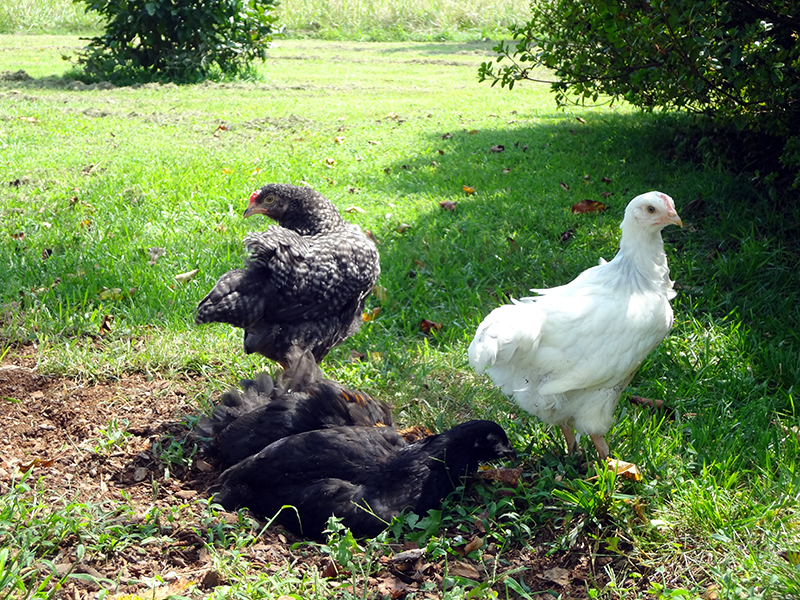
None of the other birds are named yet. I will have to see what comes to me. I also have to get Griz and the other young cockerel up on CraigsList soon. Hard to do because the birds are so cute right now—just perfect little mini chickens. But mini chickens will soon be full-blown roosters, and three on this farm is two too many.
The big chickens have met and mingled with the chicks. It’s gone okay, with the expected bullying as the older birds show the younger birds their place. Here’s Cora landing a squawk-inducing peck on a chick, while the other babies bunch up for safety and Griz tries to decide whether to be a man.
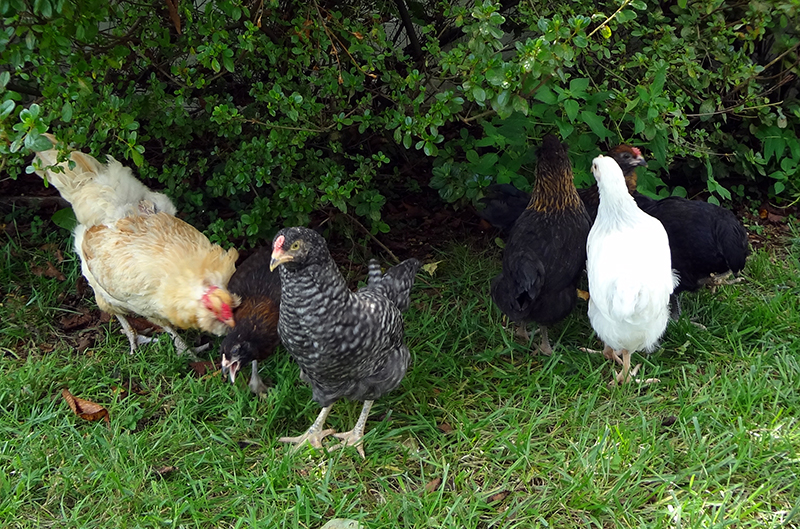
As of last night, Dahlia has rejoined her flock. It seems to be going okay for her. I bet she’s glad to be rid of these increasingly active babies in a small brooder coop.
Fifteen birds running around here is a lot, but I kind of love it. If chickens weren’t so messy, and their food so expensive, and if we didn’t have to go through winter when free-ranging isn’t as easy or safe, I would have zillions of chickens.

September 2nd, 2013 §
This morning, on the way to the compost pile, I came across this snake stretched across the path into the woods. By the time I ran for my camera it was fast disappearing into the poison ivy.
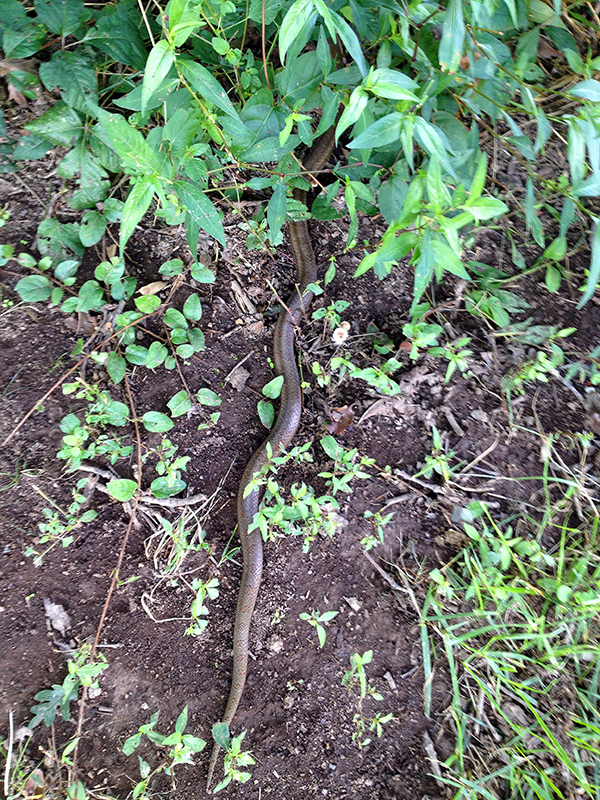
At first glance I suspected a copperhead, based upon the coloration, but a quick look at its head told me it was no viper.
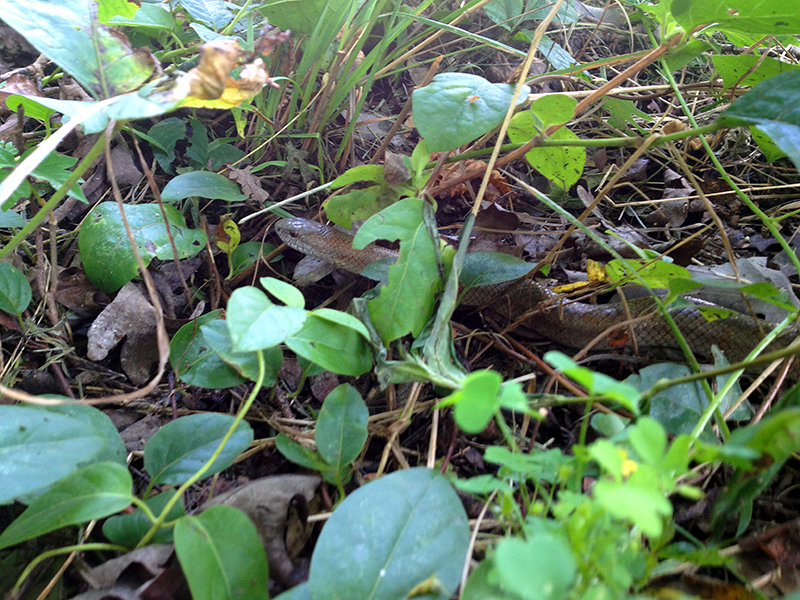
Had to go to my snake book for an i.d. I think it’s a mole kingsnake. I’ve never identified this particular snake around here, so it’s one for the life list. Apparently they live mostly underground and are often unearthed by farmers’ plows. They are superb burrowers, which fit this snake’s habit as it disappeared into the duff within seconds of taking its photo.
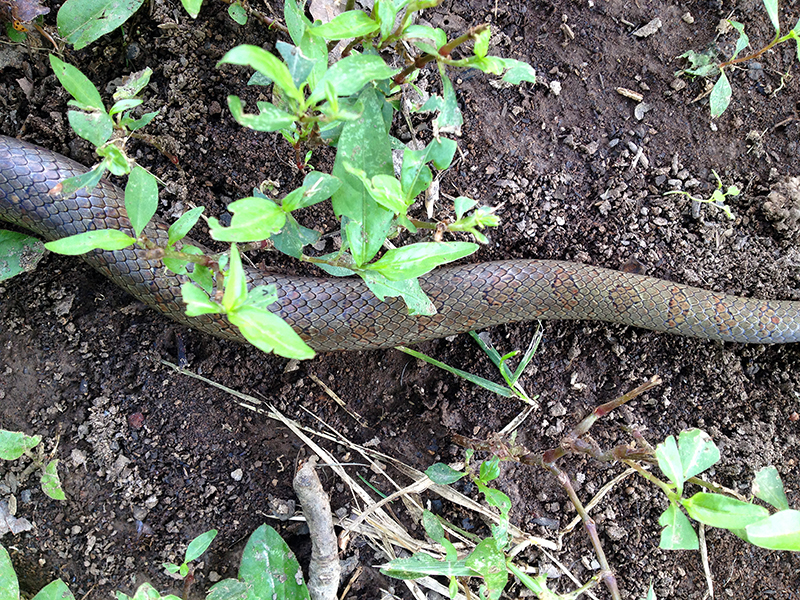
Happy birthday to me.








 August 2013
August 2013














